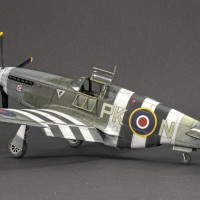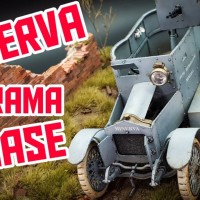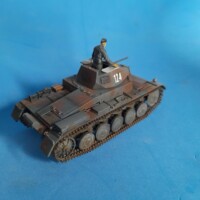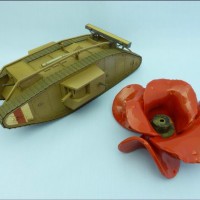Unarmed Fokker Dr.1 Trainer: 1/28 Revell Fokker Dr.1 Triplane
Hi, everyone. I built this model for the "The Great War: A Tribute to Those Who Served" Group. I don't build biplanes, so my first contribution to the group was an armored car. When the ground machine was done, I thought I might take a swing at something with more than one wing. I have been dragging this ancient Revell triplane kit around forever, so I thought it might be a good opportunity to build something with more than one wing. It was a large model with limited rigging, so my chance of success was approaching 50%. The model is fairly primitive, so this gave me a chance to try my limited 3D design and printing skills to produce some extra detail for the plane. I also found some 3D print files online for an engine, a new cowling, a new front deck for the fuselage, and some small parts. I designed all of the markings and used my wife's cutting machine to cut stencils.
I had been doing some reading about the Dr.1 and came across a photo of an unarmed, early Dr.1, that was used as a trainer for new pilots. I really like the markings and the fact that an unarmed plane was obviously different than most of the triplanes that you see. I couldn't find any photos that clearly showed what the upper fuselage looked like after they removed the guns. In fact, I could find only 2 photos of this unarmed trainer. Without any clear guidance, I created an upper deck that hopefully makes sense. Early in the build I discovered that the ailerons on the upper wing were not the same. I did some research and discovered that the first few triplanes that were built had these asymmetric ailerons, and then symmetric ailerons were used on all later planes. It made sense to me that this trainer might be an early triplane, retired, and turned into a trainer. I decided to leave the ailerons as they were. I also discovered that many of these triplanes had their painted ID info covered over when the planes were repainted, so I decided to leave the kit decals off. The decals were really ancient and I didn't really trust them.
I started the painting by spraying the light blue bottom, followed by Tamiya Deck Tan on the upper surfaces to simulate the linen covering. I used Olive Green artist oils and Turpenoid to create the camo. Once it was all dry, I used masks to create all of the markings. Very thin piano wire was used for the limited rigging. I found the whole rigging process to be frustrating, but there wasn't much of it, so I survived.
I hope those of you who are wise in the ways of WW1 planes will forgive the many inaccuracies in this model. I had fun with this build and think it came out OK, but I can't claim that it is very accurate. If you want more info on the build, please stop by the build log in the Great War group. Cheers everyone.


















The result is amazing, George @gblair
You have clearly turned this ancient kit into a winner with your skills.
The detailed 3D printed parts definitely added a lot to this kit.
Also the camouflage you created is very nice with those oil streaks.
I would already be happy if my bi-plane will look half as beautiful as your tri-plane.
Well done.,
Thanks for your kind comments, John (@johnb). Also thanks for all of your support during the build. I am sure your biplane will easily surpass this one.
Congratulations, George! As John said, you turned this kit to a winner! What a departure from the original, including the change of version to a trainer! And what a great contribution to our WWI GB!
Loved following your build thread, a pleasure as always.
Thanks for your comments, and your support during the build, Spiros (@fiveten). I am always looking for something a little different to do, so this worked perfectly.
I agree with John and Spiros, George (@gblair). You really did an outstanding job on this old Revell kit. We all have thoughts about our builds as they progress, but truly, this is very very good. Bravo George! Well Done.
Thanks for the comments, Carl (@clipper). I appreciate you following along on the build, as well as your comments which give me new things to try.
Really impressive! Where is the gun?
Thanks, Bernard (@lis). This one was a trainer, so it was unarmed. I always wonder how you can have a single seat trainer. Where does the instructor sit?
Mabye selfteach
@gblair - Great build George! You did an excellent job.
Thanks, Brian (@brithebuilder). Now I might have some time to finish the conquistador.
What a great result, George! Man, that is a fantastic model, sir and a wonderful accomplishment @gblair!
Man, that is a fantastic model, sir and a wonderful accomplishment @gblair! 
Thanks, Gary (@garybrantley). It was fun, but I don't see many more multi-wing planes in my future.
Excellent paint scheme!
Thanks, Dan (@dbdlee). Getting the streaks in the camo was definitely an experiment.
Spectacular result on that old kit. Mine has been sitting on the shelf collecting dust for decades. You've inspired me to think about doing another one!
Thanks for the kind words, Chas (@chasbunch). This was my first attempt on a multi-wing plane, so I wanted to optimize my chance of success by building something large enough for me to see. Looking forward to seeing yours. I am sure it will be spectacular.
Very nice work on this old classic. I remember building this kit when I was 10 or 12 years old. Minus the rigging of course. That engine looks superb, George @gblair. Well done!
Thanks, Eric (@eb801). This was a fun build, but the kit is starting to show its age. According to the date stamped on the inside of the fuselage, I was 6 years old when this kit came out.
Amazing result for such an ancient kit! You’ve really shown your skill in modeling here.
The engine and spinner look really great. Thanks for sharing this.
Thanks, Alfred (@alfred). Even though this kit is ancient, it still builds into a nice model, especially if you are willing to do a little extra work.
A great result of this old kit, it was a very interesting build George with your meticulous research and being able to print the parts that you needed, the steaked paint work was what made it into a masterpiece, well done.
Thanks, Ian (@firelockg). I appreciate you following along with the build. I am looking forward to the rest of your Spad.
Very nice work on this old model. It turned out looking great.
Thanks, Jay (@ssgt). It is not often that I build a kit that is almost as old as I am.
Beautifully done!
Thanks, Robert (@roofrat). I am not a fan of multi-wing planes, but this one turned out to be fun.
Excellent build! Love the paint scheme. Well done!
Thanks, Greg (@gkittinger). This kit was just like me: old, but with a some life left in it. :o)
I think you did well, it looks really cool. Beautiful work. The Fokkers had the openings covered by a simple roughly U-shaped sheet metal when removing the guns.
Thanks, Milan (@milantesar). I couldn't find any photos showing what the upper deck looked like without the guns, so I just covered it with some thin plastic simulating sheet metal. I don't think I will make another unarmed Fokker, but it is good info for someone who may want to build one in the future. Thanks for the info.
That was just an idea. I once saw a photo of a post-war Fokker where it was quite visible. However, I think you did a very good job despite the lack of information and in the field conditions there could have been practically anything.
Thanks, again, Milan (@milantesar). I was trying to use logic to decide how to cover the opening made by removing the guns. I found one photo that showed two pilots (1 in the plane and 1 standing next to the plane) where you could see a tiny bit of the area. It was clear something was there, but that was about it. It is a little frustrating sometimes. If you want a photo of one of the ace's planes, there are a bunch, but no photos of the not so famous planes. Post-war is an interesting topic. John (@johnb) got me interested in building a post-war Fokker D.VII. The Netherlands used a bunch of them, as did the US. The US had several D.VIIs that had different engines installed, which gave them a different forward fuselage. I am thinking that the 2nd multi-wing plane I build will be one of these post-war Fokkers.
Good looking build! Thanks for sharing.
Rod
Thanks for stopping in, Rod (@rodbettencourt).
Superb work, George. I love what you did with the oil painted camo - very tricky to get right in tone and texture. In fact, every element of this build is beautifully crafted. I have a 1/32 Roden Fokker F-1 Triplane waiting under the Christmas tree this year. Your work has given me some real inspiration.
Thanks for the kind words, Colin (@coling). I don't build WW1 planes, but I wanted something big for my first triplane. It is an old kit, but it was big enough for me to deal with the rigging. It was a perfect WW1 starter kit. Looking forward to your Roden triplane.
This turned out great, George. Your printed parts add a lot and it was fun to watch thus one take shape.
Thanks, John (@j-healy). This one was fun, but I think I will stick to planes with one wing for a while.